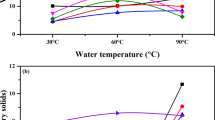Abstract
The halwa is a traditional thick sweet generally consumed by millions in the Middle East with more concentrated population in the South and Central Asia. Sweet corn halwa is one such traditional type prepared in the tribal region of middle Gujarat, India. It is one of the dairy delicacies of traditional Indian desserts, which needs to be optimized and dehydrated to assure the availability of the product during off-season and to provide good value in terms of money and enhancement of shelf life. The milk and sugar were added in 50 to 250 g/100 g and 12 to 14 g/100 g respectively for cooking of ingredients for 10 to 20 min to provide value to this traditional product for getting higher return to the entrepreneurs. The optimized sweet corn halwa was dehydrated in thin layers at 60 °C and drying data was fitted thin layer drying models. The physico-chemical properties and sensory evaluation of sweet corn halwa were evaluated during this experiment. The rehydrated product maintained similar overall acceptability, indicating comparable sensory characteristics with fresh sweet corn halwa.


Similar content being viewed by others
References
Atadesse NS, Beyene GF, Hordofa TB, Hailu AA (2020) Traditional foods and beverages in Eastern Tigray of Ethiopia. J Ethnic food 7:16
Basantpure D, Kumbhar BK, Awasthi P (2003) Optimization of levels of ingredients and drying air temperature in development of dehydrated carrot halwa using response surface methodology. J Food Sci Technol 40(1):40–44
Bruce DM (1985) Exposed-layer barley drying: three models fitted to new data up to 150 & #xB0;C. J Agric Eng Res 32:337–348
Dhiman AK, Negi V, Attri S, Ramachandran P (2017) Optimization of instant halwa mix from dehydrated pumpkin and its stability during storage. Int J Agric Sci 9:4026–4030
Fennema OE, Damodaran S, Parkin KL (2017) Fennema’s food chemistry. Routledge, London
Henderson SM (1974) Progress in developing the thin layer drying equation. Trans ASABE 17:1167–1168
Henderson SM, Pabis S (1961) Grain drying theory II. Temperature effects on drying coefficients. J Agric Eng Res 6:169–174
Hii CL, Law CL, Cloke M, Suzannah S (2009) Thin layer drying kinetics of cocoa and dried product quality. Biosyst Eng 102:153–161
Itagi HN, Singh V, Indiramma AR, Prakash M (2013) Shelf stable multigrain halwa mixes: preparation of halwa, their textural and sensory studies. J Food Sci Technol 50:879–889
Kachhadiya S, Kumar N, Seth N (2018) Process kinetics on physico-chemical and peroxidase activity for different blanching methods of sweet corn. J Food Sci Technol 55:4823–4832
Kumar N, Sarkar BC, Sharma HK (2010) Development and characterization of extruded product of carrot pomace, rice flour and pulse powder. Afr J Food Sci 4:703–717
Kumar N, Sarkar BC, Sharma HK (2011) Effect of air velocity on kinetics of thin layer carrot pomace drying. Food Sci Technol Int 17:459–469
Kumar N, Sarkar BC, Sharma HK (2012) Mathematical modelling of thin layer hot air drying of carrot pomace. J Food Sci Technol 49:33–41
Marks G (2010) Encyclopedia of Jewish food. Wiley, New York
Montgomery DC (2012) Design and analysis of experiments. Wiley, New York
Page GE (1949) Factors influencing the maximum rates of air drying shelled corn in thin layers. M.S. thesis. Purdue University. 1949. Dissertation No. AAI1300089
Ranganna S (2000) Handbook of analysis and quality control for fruit and vegetable products. Tata McGraw-Hill Education, New York
Roberts JS, Kidd DR, Zakour OP (2008) Drying kinetics of grape seeds. J Food Eng 89:460–465
Ryall AL, Lipton WJ Handling (1972) Transportation and storage of fruits and vegetables, vol 1. Avi, Westport
Sangamithra A, Venkatachalam S, John SG, Kuppuswamy K (2015) Foam mat drying of food materials: a review. J Food Process Pres 39:3165–3174
Togrul IT, Pehlivan D (2002) Mathematical modelling of solar drying of apricots in thin layers. J Food Eng 55:209–216
USDA (2020) Food data centre, U.S. Department of Agriculture. Nutrient Database for Standard Reference, Nutrient Data Laboratory Research Service, Riverdale, MD. https://fdc.nal.usda.gov/
Verma LR, Bucklin RA, Endan JB, Wratten FT (1985) Effects of drying air parameters on rice drying models. Trans Am Soc Agric Eng 28:296–301
Wang CY, Singh RP (1978) Use of variable equilibrium moisture content in modeling rice drying. Trans Am Soc Agric Eng 11:668–672
Wang Z, Sun J, Liao X, Chen F, Zhao G, Wu J, Hu X (2006) Mathematical modeling on hot air drying of thin layer apple pomace. Food Res Int 40:39–46
Yaldiz O, Ertekin C, Uzun HI (2001) Mathematical modeling of thin layer solar drying of sultana grapes. Energy 26:457–465
Author information
Authors and Affiliations
Corresponding author
Additional information
Publisher's Note
Springer Nature remains neutral with regard to jurisdictional claims in published maps and institutional affiliations.
Rights and permissions
About this article
Cite this article
Nayi, P., Kumar, N. Development of ready to reconstitute dehydrated traditional sweet corn halwa. J Food Sci Technol 58, 4486–4494 (2021). https://doi.org/10.1007/s13197-020-04930-4
Revised:
Accepted:
Published:
Issue Date:
DOI: https://doi.org/10.1007/s13197-020-04930-4




